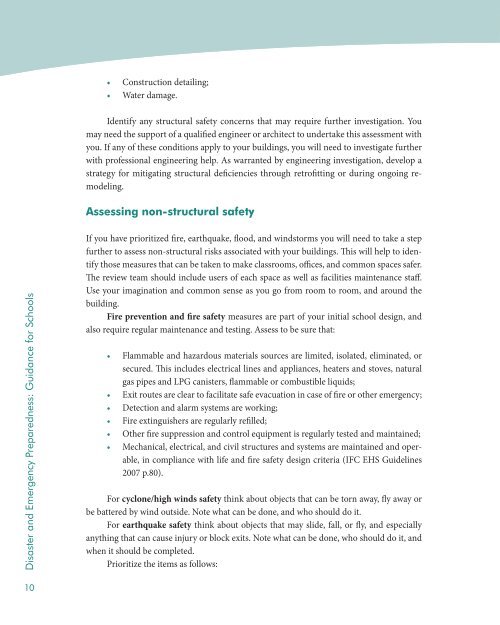Construction detailing;Water damage.Identify any structural safety concerns that may require further investigation. Youmay need the support of a qualified engineer or architect to undertake this assessment withyou. If any of these conditions apply to your buildings, you will need to investigate furtherwith professional engineering help. As warranted by engineering investigation, develop astrategy <strong>for</strong> mitigating structural deficiencies through retrofitting or during ongoing remodeling.Assessing non-structural safety<strong>Disaster</strong> <strong>and</strong> <strong>Emergency</strong> <strong>Preparedness</strong>: <strong>Guidance</strong> <strong>for</strong> SchoolsIf you have prioritized fire, earthquake, flood, <strong>and</strong> windstorms you will need to take a stepfurther to assess non-structural risks associated with your buildings. This will help to identifythose measures that can be taken to make classrooms, offices, <strong>and</strong> common spaces safer.The review team should include users of each space as well as facilities maintenance staff.Use your imagination <strong>and</strong> common sense as you go from room to room, <strong>and</strong> around thebuilding.Fire prevention <strong>and</strong> fire safety measures are part of your initial school design, <strong>and</strong>also require regular maintenance <strong>and</strong> testing. Assess to be sure that:Flammable <strong>and</strong> hazardous materials sources are limited, isolated, eliminated, orsecured. This includes electrical lines <strong>and</strong> appliances, heaters <strong>and</strong> stoves, naturalgas pipes <strong>and</strong> LPG canisters, flammable or combustible liquids;Exit routes are clear to facilitate safe evacuation in case of fire or other emergency;Detection <strong>and</strong> alarm systems are working;Fire extinguishers are regularly refilled;Other fire suppression <strong>and</strong> control equipment is regularly tested <strong>and</strong> maintained;Mechanical, electrical, <strong>and</strong> civil structures <strong>and</strong> systems are maintained <strong>and</strong> operable,in compliance with life <strong>and</strong> fire safety design criteria (IFC EHS Guidelines2007 p.80).For cyclone/high winds safety think about objects that can be torn away, fly away orbe battered by wind outside. Note what can be done, <strong>and</strong> who should do it.For earthquake safety think about objects that may slide, fall, or fly, <strong>and</strong> especiallyanything that can cause injury or block exits. Note what can be done, who should do it, <strong>and</strong>when it should be completed.Prioritize the items as follows:10
Priority 1: secure items that can kill or injure or block exits (e.g., heavy equipment,heating/cooling units, pipes, storage tanks, overhead lighting, bookshelves,hazardous chemicals, things blocking exits). Note that all exit doors should openoutwards.Priority 2: secure things can cause significant economic or cultural loss, causeinjury, or impair educational continuity (e.g., computers, audio-visual equipment,school awards, <strong>and</strong> breakables).Priority 3: secure things that, if damaged, can impede recovery.Assessing capacities <strong>and</strong> resources <strong>for</strong> mitigation, response<strong>and</strong> recoveryYour school community also has manystrengths, capacities <strong>and</strong> resources thatneed to be identified <strong>and</strong> mobilized. Asyou read through this guide you will developa good grasp of some of the physicalprotection measures, as well as response<strong>and</strong> recovery skills <strong>and</strong> resources that youwill need. Make a list of all of these needs.Then, in your school community, identifythe people <strong>and</strong> places with the knowledge,skills, <strong>and</strong> provisions you need, <strong>and</strong> find out how you can activate that capacity to reduceyour risks <strong>and</strong> speed your recovery. Identify resources <strong>and</strong> problem-solve to fill the gaps. Includename, skills/resources, location <strong>and</strong> contact in<strong>for</strong>mation.In terms of knowledge <strong>and</strong> skills <strong>for</strong> risk reduction, think about: structural engineers,environmental engineers, safety experts, facilities staff, h<strong>and</strong>ymen, plumbers, electricians,builders. For response <strong>and</strong> recovery, think about: emergency management experts, healthprofessionals, volunteer groups, scouts, women, organizing volunteers, obtaining supplies,communication experts, shelter construction, <strong>and</strong> supplies management. Find out what responseskills your staff <strong>and</strong> students already have. Use this assessment to plan <strong>for</strong> neededtraining to fill the gaps.Finally, consider the provisions you will need <strong>for</strong> response <strong>and</strong> recovery. As a rule ofthumb, collectively as a community you should plan to be able to take care of yourselves<strong>for</strong> seven days. Between home, school, <strong>and</strong> work everyone will need four liters of water perperson/per day, high energy food. As a school community you will be expected to provideleadership in this. Planning <strong>for</strong> shelter <strong>and</strong> sanitation <strong>and</strong> a site <strong>for</strong> stockpiling communalsupplies are all reasonable expectations from schools.School <strong>Disaster</strong> Management11
- Page 1: The Connected Vehicle5.9 GHz DSRC f
- Page 5 and 6: ContentsForewordviiIntroduction 1Sc
- Page 7 and 8: ForewordThis handbook and its compa
- Page 9 and 10: IntroductionMore than 400 national
- Page 11 and 12: School Disaster ManagementSchool Di
- Page 13 and 14: 1. Assessment and planningAssessmen
- Page 15 and 16: vention awareness in the school com
- Page 17: D. Find the relative risk score, by
- Page 21 and 22: On the Neighborhood Map mark vulner
- Page 23 and 24: And last but not least, students wi
- Page 25 and 26: Secure lighting fixtures to ceiling
- Page 27 and 28: Standardization - the use of common
- Page 29 and 30: Incident Command Systems Organigram
- Page 31 and 32: Staff: ahead of time, practice as a
- Page 33 and 34: necessary, or when there is not tim
- Page 35 and 36: Reunification Team: greets parents
- Page 37 and 38: When you are in transit. When trave
- Page 39 and 40: If you are indoors, stay off all te
- Page 41 and 42: Emergency Procedures Decision-TreeR
- Page 43 and 44: Report findings to Operations Chief
- Page 45 and 46: Work with the cafeteria and ICC to
- Page 47 and 48: the drill, students can debrief wit
- Page 49 and 50: ReferencesGFDRR and INEE, Guideline
- Page 51 and 52: Addenda:Comprehensive School Safety
- Page 53 and 54: addressed and implemented at the lo
- Page 55 and 56: 5. Schools have and practice polici
- Page 57 and 58: In Column B, the likelihood of occu
- Page 59 and 60: “L”-shaped, “H”-shaped, “
- Page 61 and 62: We have a fire extinguisher and mai
- Page 63 and 64: Other variationsTo make this a real
- Page 65 and 66: if there is an earthquake when they
- Page 67 and 68: Class Status Report FormReturn this
- Page 69 and 70:
Emergency Provisions ChecklistsADMI
- Page 71 and 72:
1 RADIOBATTERIES1 WHISTLE4 EMERGENC
















